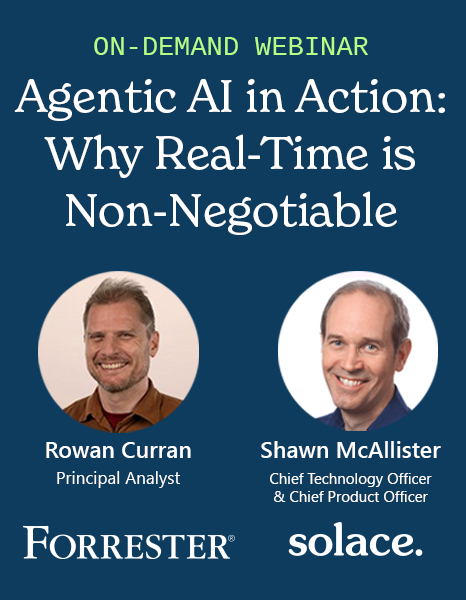Home > Blog > Artificial Intelligence
Subscribe to Our Blog
Get the latest trends, solutions, and insights into the event-driven future every week.
Thanks for subscribing.
In his talk at EDA Summit 2024, David Menninger, executive director at ISG Software Research Group, delivered a compelling argument: real-time AI requires real-time data—and that makes event-driven architecture (EDA) essential. Menninger laid out a market-backed view of how this approach helps organizations operationalize AI, overcome legacy limitations, and meet rising expectations for responsiveness across sectors. With this post, I’ll summarize his talk.
“The opportunity to act is fleeting. EDA helps you capture it—and do something with it—before it’s gone.”
David Menninger
Why EDA Matters in the Age of AI
AI adoption is skyrocketing. Enterprises are doubling the number of AI-enabled applications by 2025 and tripling their budget allocation. But it’s not just about building smarter apps—it’s about enabling timely, informed action.
- AI’s value often depends on speed — Opportunistic use cases like predictive maintenance, fraud detection, and real-time personalization require instant reactions, and the value of data diminishes very quickly.
- But a rich, full-informed understanding is critical – Decisions can’t just be fast, they need to be smart, and call on data that comes from a variety of systems, so you need to capture those events and share them across a variety of systems.
- Legacy systems still dominate — Most enterprises aren’t starting fresh; they’re embedding AI into existing apps. EDA offers a path to modernize those apps instead of ripping and replacing.
- Automation trumps alerting — Menninger emphasized the need to “close the loop”—using events not just for human awareness, insight and decision support, but to trigger effective real-time operational responses.
EDA provides the connective layer that allows AI to work as intended: in real time, across systems, and without human bottlenecks. In an environment where milliseconds matter and legacy infrastructure can’t be ignored, EDA is what transforms AI from a theoretical capability into an operational advantage.
How Enterprises are Implementing EDA
Drawing on insights from ISG’s buyer behavior studies and a data set encompassing over $200 billion in services contracts, Menninger showed that enterprises aren’t just experimenting with event-driven architecture—they’re operationalizing it. A growing share of organizations are building systems that require streaming and event data with sub-second latency, particularly in support of AI initiatives where responsiveness is critical.
This shift is happening not in greenfield environments, but within the constraints of complex, legacy-heavy IT ecosystems. As Menninger emphasized, most enterprises are embedding AI into existing applications more than twice as often as they are replacing those applications outright.
That reality makes EDA a practical necessity—not just a modern ideal. So how are organizations putting it into practice? Menninger pointed to several core strategies that are shaping successful implementations:
- Scalable microservices – Event-driven architecture naturally supports microservices that scale independently, enabling organizations to handle dynamic event volumes and expand functionality incrementally without re-architecting entire systems.
- Legacy interoperability – Rather than sidelining or replacing legacy applications, EDA allows organizations to integrate them into modern AI workflows by capturing and propagating events from systems that weren’t originally designed to communicate in real time.
- Resilience and monitoring – The decoupled nature of event-driven systems enhances fault tolerance and enables continuous health monitoring of AI processes. Events not only power the AI itself—they also help track system performance and detect when models are drifting or systems need retraining or intervention.
Menninger made it clear: implementing EDA is not about building for a theoretical future. It’s about modernizing what you already have—intelligently, incrementally, and with an eye toward responsiveness at every layer.
Real-World Impact Across Industries
Menninger cited several industry examples of high-ROI AI use cases that are real-time in nature, with EDA playing a critical role in making them operational.
- In manufacturing, AI is helping reduce costs and improve efficiency through predictive maintenance, real-time integration with suppliers and customers, and machine-to-machine communication—all of which rely on the ability to capture and act on streaming sensor and operational data as it happens.
- In banking and financial services, real-time fraud detection and risk mitigation are essential to protecting assets and maintaining trust, while intelligent automation and omnichannel customer experiences require immediate access to up-to-date customer activity and transaction data.
- In retail and eCommerce, features like recommendation engines and customer service chatbots depend on live behavioral signals—such as what a shopper is viewing or doing in the moment—in order to respond in a way that feels relevant and personalized.
Even generative AI benefits from real-time information. Menninger pointed to retrieval-augmented generation (RAG) as a technique that depends on up-to-date context to ground large language models in current business facts and customer data. Without fresh event streams, these systems risk producing outdated or irrelevant responses.
Final Thoughts
Menninger makes the case that EDA isn’t just a supporting player—it’s the connective tissue that makes modern AI possible at scale. He closed by urging organizations to prioritize use cases by value and feasibility, engage external data science talent where needed, and build out event catalogs that power intelligent, responsive systems.
Legacy systems aren’t going away, but EDA lets them play a modern role. Both predictive and generative AI require real-time data to ensure accuracy, context, and responsiveness. And by enabling closed-loop automation, EDA helps reduce the time between insight and action.
Agentic AI in Action:Why Real-Time Is Non-NegotiableOn-demand webinar featuring agentic AI case studies and expert analysis from Forrester.Watch the Webinar

Explore other posts from categories: Artificial Intelligence | Event-Driven Integration

As the leader of Solace’s analyst relations program, Roger has leveraged his technical background and analyst relations experience to develop a solid technical understanding of event-driven architecture, event streaming and event management that he uses to help analysts understand the many ways EDA and events can enable, complement, and accelerate the latest trends in computing and technology.
After kicking off his career as a programmer and professional services consultant, Roger shifted his focus to analyst relations with business intelligence innovator Cognos and IBM’s Business Analytics and Global Business Services consulting division when IBM acquired them, and for 20 years now he’s been working alongside Gartner, Forrester, IDC and other analysts to help them understand his employers’ position in the enterprise IT landscape.
Married for 30 years, Roger is the proud father of 3 adult children and enjoys DIY projects around the house and spending quiet time at the lake.


Subscribe to Our Blog
Get the latest trends, solutions, and insights into the event-driven future every week.
Thanks for subscribing.
